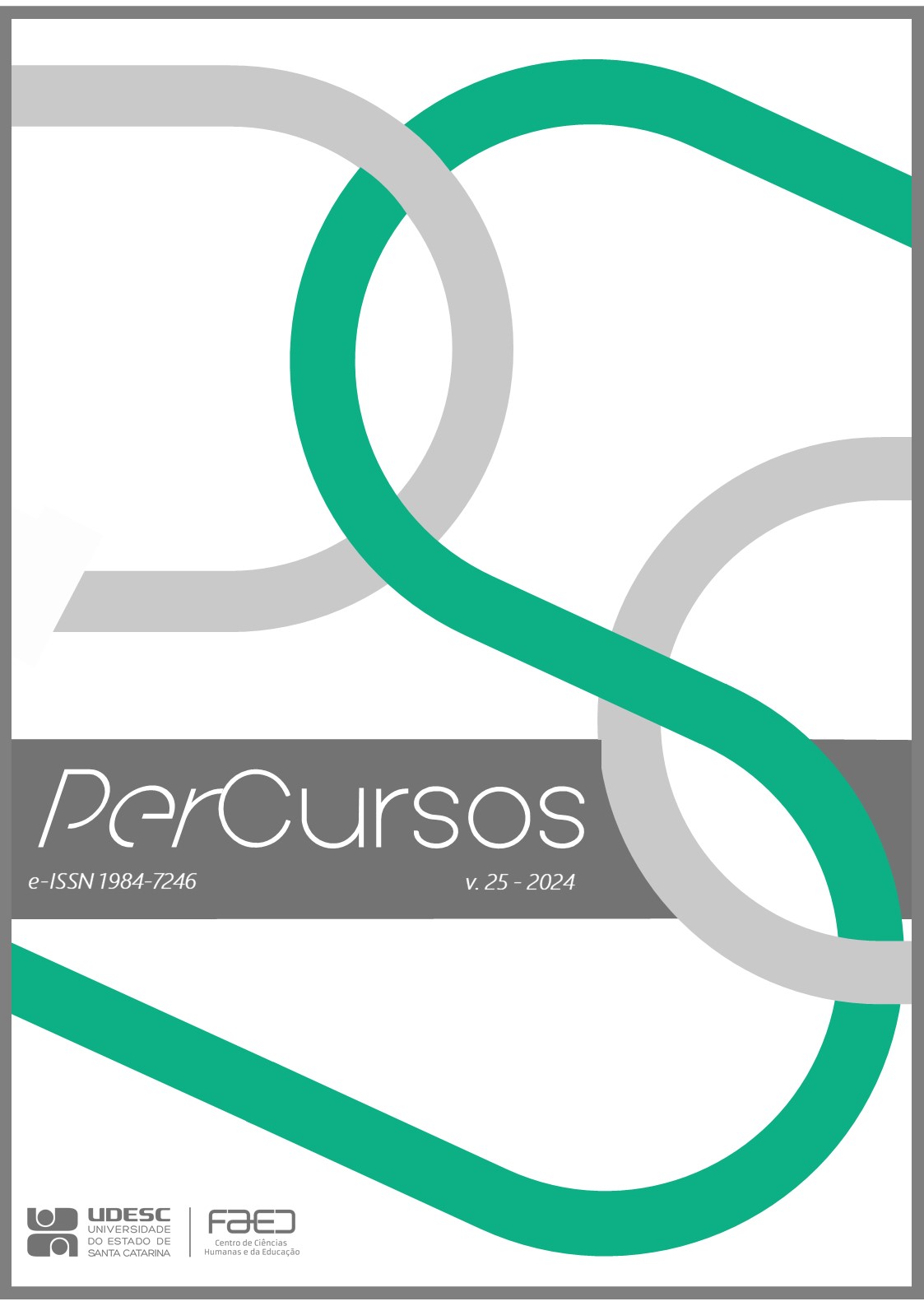Geoeducation and active methodologies in high school: a case study of the Caminhos dos Cânions do Sul Geopark
DOI:
https://doi.org/10.5965/19847246262025e0102Keywords:
environmental education, Geoparks Program, UNESCOAbstract
This study investigated the implementation of a didactic sequence focused on the Caminhos dos Cânions do Sul Geopark, using concepts of geoeducation and active teaching methodologies in the context of high school education. The research was applied to a 3rd-year class at the Jacinto Machado State Basic School in Santa Catarina in 2023. The objective was to encourage critical thinking, creativity, and reflection on the interaction between society, environment, and geodiversity. The didactic sequence included activities such as field classes, geoeducational games, and the creation of informative posters. The active methodologies employed were Microlearning, Team-Based Learning, and Flipped Classroom. The effectiveness of the sequence was evaluated through questionnaires applied before and after the didactic sequence, revealing a significant increase in students' understanding of concepts related to the Geopark. The results indicated that active methodologies are effective in promoting meaningful and autonomous learning, preparing students to face environmental and social challenges. This study contributes to the advancement of environmental education and Geoeducation, offering insights into the practical application of these approaches in high school education.
Downloads
References
BERGMANN, J.; SAMS, A. Sala de aula invertida: uma metodologia ativa de aprendizagem. 1. ed. Rio de Janeiro: LTC, 2020.
BRASIL. GEOSSIT- Sistema de Cadastro e Quantificação de Geossítios e Sítios da Geodiversidade. Serviço Geológico do Brasil - CPRM. Brasília, DF: Ministério de Minas e Energia, 2024. Disponível em https://www.sgb.gov.br/geossit/. Acesso em 27 fev. 2024.
BRILHA, J. Geoheritage: inventing a new discipline. London: Springer International Publishing. 2005.
BRILHA, J. Inventory and quantitative assessment of geosites and geodiversity sites: a review. Geoheritage, London, v. 8, n. 2, p. 119-134, 2016.
BRUM, E. C.; BORBA, A. W. de; CAMPOS, J. O. O Geodia como base educacional para a certificação do Caçapava Geoparque Mundial da UNESCO. Physis Terrae - Revista Ibero-Afro-Americana de Geografia Física e Ambiente, Lisboa, v. 5, p. 49-62, 2023.
CALLAI, H. C. A geografia escolar: e os conteúdos da Geografia. Revista Anekumene: Revista Virtual Geografia, Cultura Y Educación, Bogotá, n. 1, p. 135, 2011. Disponível em: https://revistas.pedagogica.edu.co/index.php/anekumene/article/view/7097/5764. Acesso em: 30 abr. 2023.
CASTELLAR, S. M. V. (org.). Metodologias ativas: sequências didáticas. 1. ed. São Paulo: FTD, 2016.
CATANA, M. M. D. da S. Valorizar e divulgar o património geológico do Geopark Naturtejo: estratégias para o Parque Icnológico de Penha Garcia. 2009. Dissertação (Mestrado em Património Geológico e Geoconservação) – Universidade do Minho, Portugal, 2009. Disponível em https://repositorium.sdum.uminho.pt/handle/1822/8993?mode=full#:~:text=dc.identifier.uri-,https%3A//hdl.handle.net/1822/8993,-%2D. Acesso em: 30 abr. 2022.
FAZENDA, I. C. A. Integração e interdisciplinaridade no ensino brasileiro:
efetividade ou ideologia. 6. ed. São Paulo: Edições Loyola, 2011.
FIGUEIRÓ, A. S. Geoeducação e o estudo da paisagem: interfaces e desafios. In: FALCÃO SOBRINHO, J.; SOUZA, C. J. O.; ROSS, J. L. S. (org.). A natureza e a geografia no ensino das temáticas físico-naturais no território brasileiro. 1. ed. Rio de Janeiro: Letra Capital Editora, 2023. v. 1. p. 134-160.
FIGUERÓ, A. S. (org.). Guia de práticas educativas no Geoparque Quarta Colônia. 1. ed. Santa Maria: PRE UFSM, 2024.
FILIZOLA, R. Didática da geografia: proposições metodológicas e conteúdos entrelaçados com a avaliação. Curitiba: Base Editorial, 2009.
GUIMARÃES, T. Patrimônio geológico e estratégias de geoconservação: popularização das geociências e desenvolvimento territorial sustentável para o litoral sul de Pernambuco (Brasil). Programa de Pós-Graduação em Geociências: Universidade Federal do Pernambuco, 2016;
GUIMARÃES, T.; MARIANO, G.; SÁ, A. A. Inventário e avaliação qualitativa como subsídio à geoconservação e ao geoturismo: Litoral Sul do Estado de Pernambuco (Nordeste-Brasil). Revista Brasileira de Geografia Física, Recife, v. 10, n. 04, p. 1218-1238, 2017.
LEMOS, A. Cultura do remix. [S. l.]: UFBA, 2009.
LESSIG, L. Remix. London: Penguin Press, 2008.
LIKERT, R. A technique for the measurement of attitudes. Archives of psychology, New York, n. 140, p. 1-55, 1932.
MICHAELSEN, L. K.; KNIGHT, A. B.; FINK, L. D. Team-based learning: a transformative use of small groups in college teaching. United Kindgon: Stylus Publishing, 2004.
MOURA-FÉ, M. M.; PINHEIRO, M. V. A.; JACÓ, D. M.; OLIVEIRA, B. A. Geoeducação: a educação ambiental aplicada na geoconservação. In: SEABRA, G. (org.). Educação ambiental & biogeografia. Ituiutaba: Barlavento, 2016. v. II. p. 829-842. Disponível em: https://www.researchgate.net/publication/309032152_Geoeducacao_a_educacao_ambiental_aplicada_na_geoconservacao. Acesso em: 17 mar. 2023.
PLÁCIDO, R.; CASTRO, C. LEME: Laboratório de Espaços e Memórias da Educação Profissional e Tecnológica de Santa Catarina. Estrabão, [s. l.], v. 2, n. 1, p. 12-22, 2021. DOI: 10.53455/re.v2i.3a. Disponível em: https://doi.org/10.53455/re.v2i.3a. Acesso em: 15 jul. 2024.
RIZZATTI, M. Cartografia escolar, inteligências múltiplas e neurociências no ensino fundamental: a mediação (geo)tecnológica e multimodal no ensino de geografia. Santa Maria: Programa de Pós-Graduação em Geografia da Universidade Federal de Santa Maria, 2022.
SAVIANI, N. Saber escolar, currículo e didática: problemas da unidade conteúdo/método no processo pedagógico. 4. ed. Campinas: Autores Associados, 2003.
SILVA, M. L. N.; NASCIMENTO, M. A. L.; MANSUR, K. L. Quantitative assessments of geodiversity in the area of the Seridó Geopark Project, Northeast Brazil: grid and centroid analysis. Geoheritage, London, v. 11, n. 3, p. 1177-1186, 2019a.
SILVA, M. L. N.; NASCIMENTO, M. A. L.; MANSUR, K. L. Principais ameaças à geodiversidade identificadas no território do Projeto Geoparque Seridó. Holos, Fortaleza, v. 1, p. 1-16, 2019b.
UNESCO. Geociências e geoparques mundiais da UNESCO. [S. l.]: Unesco, 2022. Disponível em:
https://pt.unesco.org/fieldoffice/brasilia/expertise/earth-science-geoparks. Acesso em: 28 abr. 2022.
Published
How to Cite
Issue
Section
License
Copyright (c) 2025 PerCursos

This work is licensed under a Creative Commons Attribution-NonCommercial 4.0 International License.


